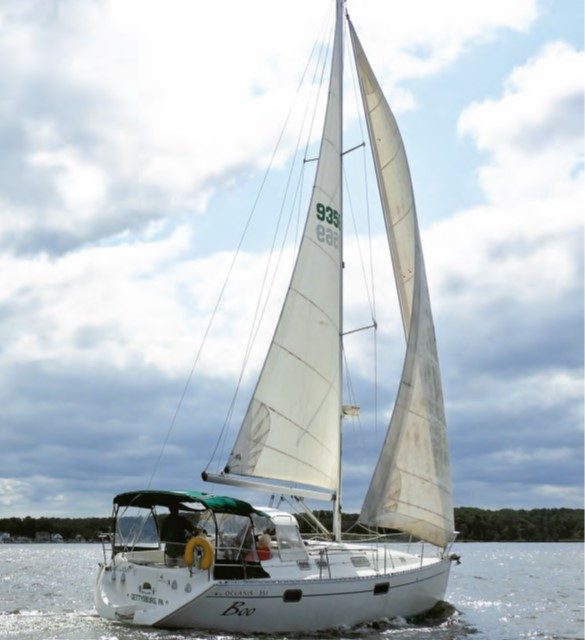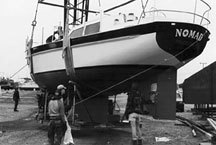A Fun, Fast Family Cruiser
Issue 136: Jan/Feb 2021
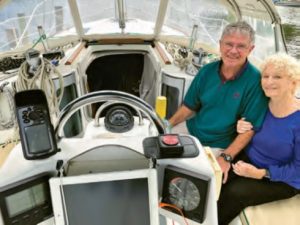
Dave and Pat Crowner are well protected in the cockpit by the Wavestopper hardtop dodger they installed. Note the curved vertical windows at the corners of the companionway.
Dave and Pat Crowner had trailer-sailed their Flying Scot from the Florida Keys to New York’s Cayuga Lake when they started chartering keelboats in the British Virgin Islands, Greece, and Turkey. On one of those BVI trips they chartered a Beneteau, and that experience, plus sailing with friends on the Chesapeake Bay, prompted them to go boat shopping at the U.S. Sailboat Show in Annapolis, Maryland. They left with a Beneteau Oceanis 351, and they haven’t looked back since.
Since christening Boo in June 1995, they (and now their affable boat dog, Hannah) have sailed her to Maine, Florida, the Bahamas, and multiple points in between. Though last summer COVID-19 kept them on the Chesapeake Bay, where they’re based at Oak Harbor Marina in Pasadena, Maryland, they were still making plans to go south again in 2021.
When asked what he likes most about Boo, Dave doesn’t hesitate: “It’s just that it sails so well and so easily for just the two of us. It’s all so predictable.”
And that is precisely what Beneteau was after when it introduced this 35-footer in 1994—a solid, mid-sized boat that could take a couple or a small family sailing fast, comfortably, and efficiently with no surprises.
“Beneteau had some smaller boats that were entry level, and this was the next step up,” says Barrett Canfield, president of South Coast Yacht Sales in San Diego, California, who has been selling Beneteaus for 25 years. “We call them our bread-and-butter boats… it’s a great cruiser, take it anywhere, very stable.”

History
As the largest boatbuilder in the world, Beneteau hardly needs much introduction. In 1986, the French-based company opened a U.S. manufacturing plant in Marion, South Carolina, to produce boats for sale in North America. In July 2020, Groupe Beneteau announced it would close the South Carolina plant by the end of the year, due in part to the economic effects of COVID-19. The plant has produced over 8,700 boats, including the Crowners’.
Designed by Jean Berret, the 351 replaced a Philippe Briand-designed 35-footer called the Oceanis 370. In 1997, Beneteau introduced the Oceanis 352, which was essentially the same boat as the 351 with some minor interior modifications. Canfield says that all of these boats were put through their paces in the Moorings charter fleet, and data gathered there, plus suggestions from owners, informed modifications and updates to the design.
Design and Construction
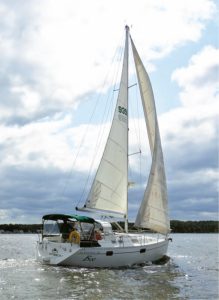
The Beneteau 351 has a very flat sheer and short overhangs that maximize interior volume. The wide beam creates form stability that minimizes heel.
The 351 was designed to be a comfortable, predictable family cruiser. In a brochure for the 352, whose hull and sail plan are identical to the 351, Beneteau said the goal was to offer “a very maneuverable boat under power and sail. This is not surprising when you take into account her taut lines, maximum waterline length, and wide beam, insuring excel¬lent initial (form) stability.”
The boat draws 5 feet with an externally mounted keel, attached via through-bolts into the bilge, with winglets that provide 3,748 pounds of ballast.
Beneteau is known for its efficient assembly line methods and tight budget and quality control. Nearly all components are prefabricated and dropped in at the designated place on the line, and Beneteau precisely controls all production aspects.
The 351’s hull is solid, hand-laid fiberglass with an internal fiberglass liner reinforced with unidirectional rovings. According to Canfield, by the time the 351 was in production Beneteau was using its Beneteau Watershield System (BWS), which introduced a vinylester layer in the hull layup in an effort to reduce or eliminate osmotic blistering. (This patented system was first used in 1988 in Beneteau’s European plants, according to a Beneteau owner’s manual.) Some owners’ forums have noted blistering nonetheless, however the Crowners have had no issues with blisters, and Boo’s bottom is in pristine condition. They do haul her every winter.
The hull is strengthened by a substantial interior grid system and pan (liner) on which all of the boat’s interior features—including the head compartment, settees, bulkheads, and furniture—are attached. Bulkheads are fitted into grooves in the liner and glued in place. The deck, which has a reciprocal interior liner, is cored with end-grain balsa to enhance stiffness and reduce noise.
The hull-to-deck joint is an inward-flange, meaning the fasteners connecting the hull to deck are vertical on deck, not horizontal on the hull sides, where they can be more easily damaged. On Boo this joint is mechanically fastened initially with sheet-metal screws and sealed with a structural adhesive like 3M 5200. The joint is permanently connected with through-bolts that also attach an aluminum toerail on top, which protects the flange on deck.
Rig and Sailhandling
The deck-stepped mast, boom, and solid vang are Z-Spar products; the mast is anodized aluminum with double spreaders. Standing rigging— 1 x 19 stainless steel wire with swaged terminals—consists of independent forward lowers whose adjustable turnbuckles terminate at a pad eye through-bolted to the deck. Cap shrouds and aft lowers terminate in a combined attachment point at mid-deck. This fitting is connected to the hull’s internal grid system via an adjustable tie rod, effectively transferring the sailing loads to the hull.

The cockpit is comfortable for entertaining and ergonomically well set up for sailing. The centerline table also provides a place to comfortably wedge one’s feet while sailing at a heel.
The mast has twin backstays terminating on the outboard corners of the transom, keeping the swim platform clear of obstructions. A compression post below supports the mast base.
The boats came equipped with an in-mast mainsail furler and headsail furler. The Crowners replaced both on Boo with Harken furlers after the originals were damaged in a storm.
The genoa sheets run through cars attached to tracks bolted to the crown of the cabintop, which helps keep the sidedecks clear and provides for close sheeting. The mainsheet is double-ended with the traveler forward of the companionway.
There are only two winches— Lewmar 44s—for all sailhandling and line control, mounted after the jammers. Although this seems minimal, this arrangement worked extremely well during our sea trial. The only hitch seemed to be that the traveler control lines could not be adjusted through the dodger, which the Crowners added to provide more protection in the cockpit.
On Deck
The 351’s deck is clean and clear, with minimal clutter. The anchor locker has a substantial platform aft on which the Crowners mounted a Lewmar Series 1000 windlass. Anchor chain falls into a deep well.
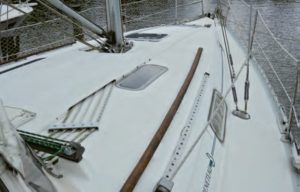
All sailhandling control lines run beneath a sea hood just forward of the companionway and are led aft via organizers to a battery of line jammers on either side of the companionway.
Moving aft, two hatches on the cabintop forward of the mast provide ventilation below, and two deck-bedded, lozenge-shaped, fixed port¬lights aft of the mast provide substantial light below. Though they look ripe for leaks, Dave Crowner says that hasn’t been a problem.
Two varnished teak handrails are mounted on the cabintop parallel to the genoa tracks. The gentle camber of the cabintop encroaches somewhat on the sidedecks, but on the whole, passage forward and aft is quite clear and feels safe.
The Crowners installed a Wavestopper hard dodger whose stainless steel handholds give an extra measure of security entering and exiting the cockpit. The dodger has isinglass sides and front, and attaches via a removable canvas “moonroof” to an aftermarket bimini.
The cockpit seats are comfortable with well-angled seatbacks, and when the boat is heeled it’s easy to brace one’s feet at the table base.
Storage is under the seats on each side. The starboard side is shallower due to the quarter berth beneath, and it also houses the holding tank. The Crowners have made excellent use of this space by storing all of their well-organized, easily accessible safety gear here.

The cavernous portside locker allows the Crowners to easily stow their spinnaker, inflatable dinghy, 2-hp Honda outboard, docklines, fenders, and other gear. This locker also houses the refrigeration compressor.
Two bump-outs at the aft end of these lockers enable easy passage to the helm. Standing at the 42-inch wheel, visibility forward and aft is excellent.
The binnacle provides multiple options for instruments; the Crowners have depth, boat speed, and wind speed and direction. Their primary chartplotter is an iPad, which sits on the binnacle and uses the iNavX charting program.
The helm seat folds all the way back onto the transom to allow walk-through access to the sugar-scoop swim platform, where an extendable ladder and handhold make it easy to get in and out of the water.
Below Deck
The companionway is flanked by two unusual, vertical, curved portlights, which provide light to the galley and quarter berth. Four wide steps lead below, with the L-shaped galley immediately to port. Storage is ample, and best of all there’s a small hatch directly above to provide the chef with fresh air. The only flaw is there’s no way for those in the galley to secure themselves in rough weather.
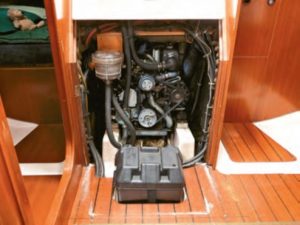
The lower half of the companionway steps can be removed in a single unit to allow access to the front of the engine and the engine start battery. Boo was delivered with a Perkins diesel rather than the more common Yanmar.
Several accommodation plans were offered. On Boo, to starboard is a quarter berth cabin, and directly forward is the head with 6-feet 1-inch headroom and a shower. Molded entirely in one piece, the head compartment is easy to maintain and clean. Other plans show the quarter berth to port. Optional were two quarter berths port and starboard and the galley in place of the port settee.
The saloon, finished in warmly varnished cherry and brightly lit from ample deck hatches and portlights, provides 6 feet 3 inches of headroom. The nav station is directly forward of the galley at the end of the port settee. To starboard, a luxurious semi-circle settee surrounds the cherry table. This table can be lowered—fireman style down the compression post—and cushions inserted to provide extra sleeping area. Storage is voluminous beneath the settees.
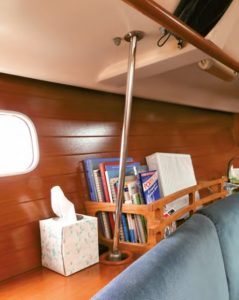
Rather than traditional chainplates, a tie rod connects shrouds to the hull’s internal grid structure behind the settees and helps transfer sailing loads.
The forward sleeping cabin features a V-berth with a hanging locker to starboard and an opening hatch above.
In terms of systems, Beneteau did a good job providing access to the critical pieces. The engine—on Boo an original 28-hp Perkins M30 Perama—is located under the companionway steps. Two hatches, one in the quarter berth and one in the galley, provide side access. (Although the 351 spec sheet shows the boat was powered with a Yanmar 3GM30, some boats, like Boo, evidently came with the Perkins. On online forums, owners tend to prefer the Yanmar because parts are easily available, but the Crowners are pleased with their Perkins and have suffered no major issues with it.)
Access to the drive train is via a removable panel under the quarter berth. Wrestling the mattresses can be quite a job, but once they’re out of the way, the stuffing box, couplers, and gear/transmission are readily accessible. Also under the quarter berth are the house batteries. Access is good but getting batteries in and out of the doorway to this compart-ment can be challenging. The 24-gallon stainless steel fuel tank lies aft of the batteries.
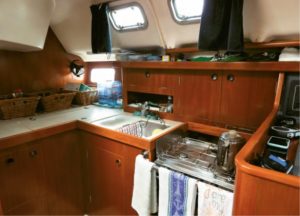
The galley includes a three-burner stove with oven, two stainless steel sinks, and a top-loading refrigerator chilled with an Adler Barbour box system.
One potential issue arises when leaks develop in the freshwater plumbing system. The feed lines, for example to the cockpit shower, are sandwiched between the liner and the hull. If one of these lines springs a leak, repair will be extremely difficult. That, along with condensation and a somewhat noisier environment, are drawbacks of interior pans, especially those that extend up the hull sides.
Underway
We sailed Boo on the Patapsco River in a blustery 12-20 knots that raised a healthy chop as we ventured further from the mouth of Rock Creek, where Oak Harbor is located. Leaving the dock, I quickly noticed how responsive the boat was under power. The Crowners have installed a Flexofold three-blade feathering propeller, which moved the boat quite effortlessly. At 2,000 rpm, into about a 10-knot wind, we motored at 5.8 knots.
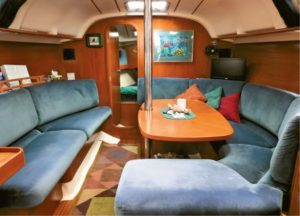
The saloon seems enormous for a 35-foot boat. The sculpted cushions overhang their foundations for leg comfort, and the mast compression post is a good handhold for moving forward and aft through an otherwise wide-open space.
Once clear of the Rock Creek channel, the mainsail and genoa unfurled easily. Under sail, the boat quickly acceler¬ated, and on a broad reach we saw boat speeds of around 9 knots with an occasional leap up to 10. Boats with this sort of hull form like to be sailed relatively flat, and I wondered how this boat would handle in these strong winds with full main and jib. The boat honestly sailed like it was on rails. I could easily control it with two fingers on the wheel on a broad reach in 20 knots of breeze, and it showed no tendency to round up.
Steering input was almost immediate, and the boat felt like a fast dinghy. Closer to the wind, the boat was of course slightly slower, but still incredibly easy to sail. The motion was very predictable with no pounding and very little water over the deck, despite the steepening chop and significant puffs. With all sail controls leading under the dodger, it was easy to wedge into the companionway and apply all the force needed to trim. With the higher-cut 140-percent genoa and an uncluttered foredeck, tacking was effortless. The only sailhandling issue was access to the mainsheet traveler control lines, which were outside of the dodger.
Sailing into sheltered water and lighter air back in Rock Creek, boat speed was still quick for the wind speed. Off the wind we were seeing 4-5 knots in often less than 10 knots true. Thanks to the ease of sailhandling, we were able to carry full sails reaching all the way up the narrowing creek to the marina, where we easily and quickly transitioned back to power for docking.
Conclusion
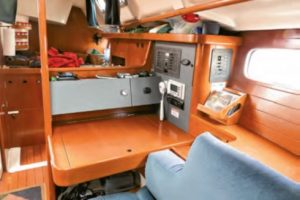
The aft-facing seat of the navigation station is at the end of the slightly curved portside settee.
The Crowners purchased Boo brand new in 1995 and immediately placed her in charter with Annapolis Yacht Sales to help defray the costs of ownership. The boat was in charter for nine years. Since 2010, the boat has been docked and main¬tained at Oak Harbor Marina, where a service record review shows she is an economical boat to own. The Crowners have had to replace both furlers due to storm damage, a leaking through-hull, and an exhaust system damaged by a bag covering the raw-water intake. Other than that, it’s been normal maintenance.
Despite the boat’s years in charter and the many thousands of miles that the Crowners have put under her keel from Maine to the Bahamas, she’s in excellent condition, which speaks both to their care and the boat’s quality.
Barrett Canfield at South Coast Yacht Sales says these boats sell quickly because they are still so good at what they were built to do and provide solid value. “A nice one is between $55,000 and $60,000 right now,” he says. “It’s a lot of boat for the money.”
In my career, I have learned there are two types of sailboats: some that are hard to sail, and some that are just plain fun to sail. The Beneteau Oceanis 351 is a fun boat. The Crowners clearly feel this way, too, and they’re always surprised when they’re sailing by other boats whose owners, in the same conditions, would rather motor.
“She is easy to sail, and we can make good speed,” Dave says. “When we go out, if no other sailboat is in the vicinity, we are cruising, but if one other boat is nearby, we’re racing!”
John Clarke, a lifelong sailor, is yard manager at Oak Harbor Marina in Pasadena, Maryland. He has been in the boat service and repair industry for over 40 years and isn’t easy to impress when it comes to boat quality and performance. He loves good old boats, especially his family’s 1978 Peterson 34.
Thank you to Sailrite Enterprises, Inc., for providing free access to back issues of Good Old Boat through intellectual property rights. Sailrite.com

